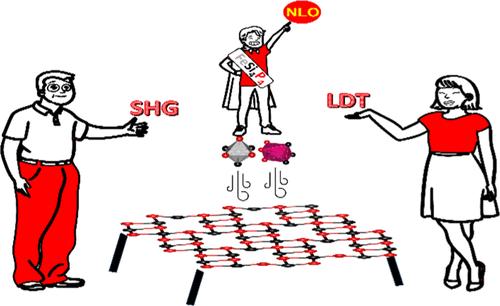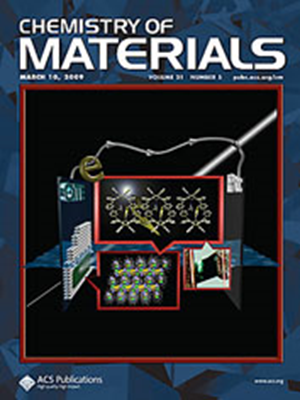FeSi4P4 and CoSi3P3: Hidden Gems of Ternary Tetrel Pnictides with Outstanding Nonlinear Optical Properties
IF 7
2区 材料科学
Q2 CHEMISTRY, PHYSICAL
引用次数: 0
Abstract
Metal silicon phosphides have shown promise as nonlinear optical materials. To be practically useful and cheap, earth-abundant 3d transition metals are preferred over their scarcer and more expensive 4d and 5d counterparts. We developed a synthetic method to produce polycrystalline bulk powders and millimeter-sized single crystals of ternary compounds FeSi4P4 and CoSi3P3. Both studied compounds have noncentrosymmetric and chiral crystal structures with ordered Si/P arrangements as was confirmed by single-crystal X-ray diffraction and solid-state NMR. Despite the presence of the transition metal, FeSi4P4 and CoSi3P3 are semiconductors with direct band gaps of 1.3 and 1.6 eV, respectively, indicating low-spin d6 electronic configuration for octahedral Fe2+ and Co3+. Relative to reported sulfide materials, FeSi4P4 and CoSi3P3 small band gap semiconductors demonstrate an outstanding combination of second-harmonic generation (SHG) activity and laser damage threshold (LDT). Both studied materials are phase-matchable with a 2.09 μm laser and not only exhibit 2.5–3.0 times stronger SHG signal than that of the state-of-the-art AgGaS2 standard but also demonstrate an LDT response of 2.3–2.5 times higher than that of AgGaS2 (at 1.09 μm laser with a pulse width of 10 ns)─which is unprecedented for small band gap semiconductors.

FeSi4P4和CoSi3P3:具有出色非线性光学特性的三元四锑化合物中的隐秘宝石
金属磷化硅有望成为非线性光学材料。为了达到实用和廉价的目的,人们更倾向于使用丰富的 3d 过渡金属,而不是稀缺和昂贵的 4d 和 5d 金属。我们开发了一种合成方法,可制备三元化合物 FeSi4P4 和 CoSi3P3 的多晶块状粉末和毫米级单晶。单晶 X 射线衍射和固态核磁共振证实,所研究的这两种化合物都具有非中心对称和手性晶体结构,Si/P 排列有序。尽管存在过渡金属,FeSi4P4 和 CoSi3P3 仍是直接带隙分别为 1.3 和 1.6 eV 的半导体,表明八面体 Fe2+ 和 Co3+ 的低自旋 d6 电子构型。与已报道的硫化物材料相比,FeSi4P4 和 CoSi3P3 小带隙半导体在二次谐波发生(SHG)活性和激光损伤阈值(LDT)方面表现出卓越的综合性能。所研究的这两种材料都可与 2.09 μm 激光器进行相位匹配,不仅显示出比最先进的 AgGaS2 标准强 2.5-3.0 倍的 SHG 信号,而且还显示出比 AgGaS2 高 2.3-2.5 倍的 LDT 响应(在 1.09 μm 激光器和 10 ns 脉冲宽度条件下)--这在小带隙半导体中是前所未有的。
本文章由计算机程序翻译,如有差异,请以英文原文为准。
求助全文
约1分钟内获得全文
求助全文
来源期刊

Chemistry of Materials
工程技术-材料科学:综合
CiteScore
14.10
自引率
5.80%
发文量
929
审稿时长
1.5 months
期刊介绍:
The journal Chemistry of Materials focuses on publishing original research at the intersection of materials science and chemistry. The studies published in the journal involve chemistry as a prominent component and explore topics such as the design, synthesis, characterization, processing, understanding, and application of functional or potentially functional materials. The journal covers various areas of interest, including inorganic and organic solid-state chemistry, nanomaterials, biomaterials, thin films and polymers, and composite/hybrid materials. The journal particularly seeks papers that highlight the creation or development of innovative materials with novel optical, electrical, magnetic, catalytic, or mechanical properties. It is essential that manuscripts on these topics have a primary focus on the chemistry of materials and represent a significant advancement compared to prior research. Before external reviews are sought, submitted manuscripts undergo a review process by a minimum of two editors to ensure their appropriateness for the journal and the presence of sufficient evidence of a significant advance that will be of broad interest to the materials chemistry community.
 求助内容:
求助内容: 应助结果提醒方式:
应助结果提醒方式:


